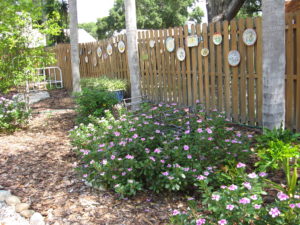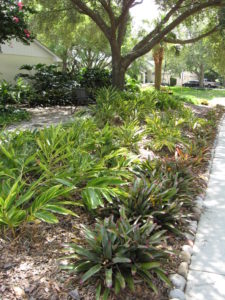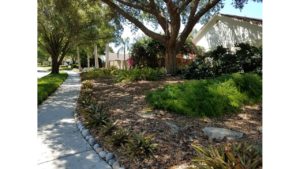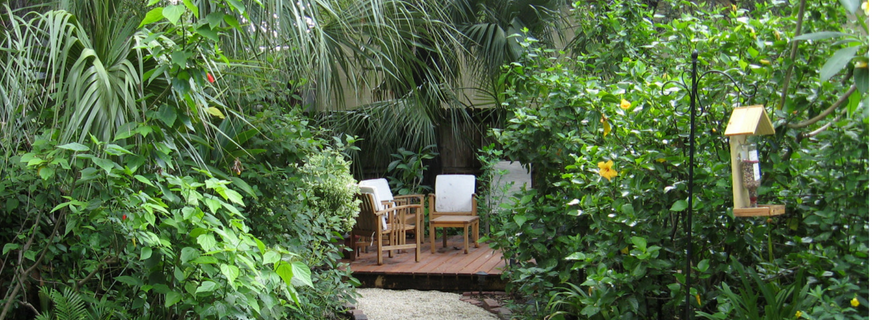By Lynn Barber, Florida-Friendly Landscapingtm Agent
 After all the rain this week, it’s probably hard to remember that May is usually a dry month when people who have planted drought-tolerant landscapes are rejoicing in their wise decision, while their neighbors are running sprinklers that may use up to half of their water bill.
After all the rain this week, it’s probably hard to remember that May is usually a dry month when people who have planted drought-tolerant landscapes are rejoicing in their wise decision, while their neighbors are running sprinklers that may use up to half of their water bill.
It’s also a prime time to nominate your water-saving yard for the Community Water-Wise Awards, sponsored by Tampa Bay Water to recognize individuals and businesses committed to conserving our water resources. Residential and commercial landscapes in Pasco, Pinellas or Hillsborough counties are eligible for the awards.
In many Florida households, as much as half of household water is used outdoors, for lawn and garden irrigation. That’s an unnecessary expense – both financially and environmentally – because you can have an attractive landscape by following the nine principles of the Florida-Friendly LandscapingTM (FFL) Program.
The principles include:
-
- Right plant right place. Even native plants have very specific sun and water requirements. Select plants that match a site’s soil, light, water, and climatic conditions and consider plant size over time. Aim for a diversity of trees, shrubs, groundcovers, and flowers. Once these plants are established, they’ll require little—if any—supplemental water, fertilizer or pesticide.
- Water efficiently. Along with choosing the right plant for the right place, group plants with similar water needs together. Hand water when possible, and check your irrigation system to ensure that it’s zoned appropriately. Repair any leaks, clogs or breaks. Cut grass on a high setting to shade the soil and reduce water loss.
- Fertilize appropriately. Many local governments in the Tampa Bay region have very specific guidelines that prevent the sale or use of nitrogen fertilizer during rainy months to protect surface waters from excess nutrients. Use fertilizers with slow-release nitrogen and little or no phosphorous and never fertilize before a heavy rain. For a quick summer greenup, use iron supplements (ferrous sulfate or chelated iron) on your turf instead of nitrogen fertilizer. If you use reclaimed water for irrigation, be aware that it does
 contain some nutrients and adjust the amount of fertilizer accordingly.
contain some nutrients and adjust the amount of fertilizer accordingly. - Mulch. It helps retain soil moisture, protects plants, and inhibits weed growth. It gives your landscape a neat, uniform appearance and is a great Florida-Friendly choice for hard-to-mow slopes and shady spots. Keep a 2- to 3-inch-deep layer of mulch on plant beds. Always leave at least 2 inches of space around tree trunks to prevent rot. Create self-mulching areas under your trees by letting fallen leaves lie. Be sure to choose sustainably harvested mulch like melaleuca, pine straw, or eucalyptus. Avoid cypress mulch, as its origins may be difficult to determine. Pine straw should not be used in areas prone to wildfire risk.
- Attract wildlife. Wildlife literally brings your yard to life – but it’s hard for anything to survive in a perfect turf landscape. Provide food, water, and shelter for birds, butterflies and bats by selecting plants with seeds, fruit, foliage, flowers, or berries that animals can eat. Supply water, such as a rain garden or bird bath.
- Manage yard pests responsibly. Concerns for human and environmental health have led scientists to recommend Integrated Pest Management (IPM), a strategy that helps gardeners manage pests with as few chemicals as possible. Reducing insecticide use can be good for you and many animals and beneficial insects. They eat pests and help pollinate your flowers. To prevent disease and insect outbreaks, select pest-resistant plants and put them in suitable locations. Use appropriate amounts of water and fertilizer, and mow grass at its proper height. When problems do arise, remove the affected leaves or plant parts, or pick the insects off by hand. Don’t treat by default—some of the insects you see may be beneficial, actually helping to control pest insect populations.
 Yard waste. This is really a misnomer because it’s so easy to recycle. Decomposed organic matter, like pruned branches or grass clippings, releases nutrients back to the soil in a form that plants can easily use. Try composting, combining “green” (nitrogen-rich) and “brown” (carbon-rich) materials, such as grass clippings, weeds, plant trimmings, egg shells, coffee grounds, tea bags, twigs and branches, pine needles, corncobs, and shredded cardboard. Turn or stir the pile as you build it, and add water so microorganisms can break down the material, but make sure you cover the pile to protect it from rain. Add this nutrient-rich mixture to your soil and enjoy the benefits: looser soil with greater water-holding capacity and increased fertility—not to mention less garbage going to the landfill.
Yard waste. This is really a misnomer because it’s so easy to recycle. Decomposed organic matter, like pruned branches or grass clippings, releases nutrients back to the soil in a form that plants can easily use. Try composting, combining “green” (nitrogen-rich) and “brown” (carbon-rich) materials, such as grass clippings, weeds, plant trimmings, egg shells, coffee grounds, tea bags, twigs and branches, pine needles, corncobs, and shredded cardboard. Turn or stir the pile as you build it, and add water so microorganisms can break down the material, but make sure you cover the pile to protect it from rain. Add this nutrient-rich mixture to your soil and enjoy the benefits: looser soil with greater water-holding capacity and increased fertility—not to mention less garbage going to the landfill.- Reduce stormwater runoff. Nearly everything we do in our yards ultimately ends up in Tampa Bay. Minimize the use of fertilizers and pesticides and retain use as much of the rainfall and irrigation water that lands on your landscape as possible. Creating shallow rain gardens, or shape the earth on slopes with berms (rises) and swales (dips), to help slow runoff from heavy rains and allow the water time to soak into the ground. Make sure your downspout is pointed into the garden, not towards a sidewalk or driveway. Wherever possible, maintain permeable walkways, driveways, and patios of brick, gravel, earth, or crushed shell, to allow rain to soak into the ground.
- Protect the waterfront. While we all impact surface waters, if you’re lucky enough to live on the water you need to be even more careful. One of the most important steps you can take to protect any water body is maintaining a 10-foot “maintenance-free zone” around it. Do not mow, fertilize, or use pesticides in this zone. Don’t let any grass clippings or pet wastes get into the water, as these carry nutrients and harmful bacteria. If you maintain a riparian (water’s edge) zone, install native aquatic plants such as giant bullrush and maidencane, and remove invasive exotic species like water hyacinth and purple loosestrife. A stormwater pond or canal can become an aesthetically pleasing and lively place, edged with plants and home to wildlife. Work with your neighbors or homeowner association to make your stormwater pond a Florida-Friendly neighborhood amenity.
 These principles serve as a yardstick for evaluating landscapes nominated for a Water-Wise Award. Winning landscapes balance attractive designs with plants, landscape elements and water efficient irrigation techniques that have a positive impact on our environment.
These principles serve as a yardstick for evaluating landscapes nominated for a Water-Wise Award. Winning landscapes balance attractive designs with plants, landscape elements and water efficient irrigation techniques that have a positive impact on our environment.
You can view photographs of past winners at http://tampabaywaterwise.org and watch short videos illustrating how the winning landscapes demonstrate Florida-Friendly Landscape principles. The deadline for entry is June 30. It only takes about 10 minutes to apply online. Attaching a photo or two is helpful. On-site landscape evaluations will be scheduled and conducted in May, June and July with homeowners and business owners present.
Winning homeowners will receive a handmade mosaic stepping stone; businesses can opt for a plaque instead. You will also get permanent recognition on the site as a winner of the award. For more information, contact Lynn Barber at barberl[at]hillsboroughcounty.org or (813) 744-5519 ext 54105.

